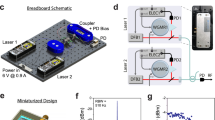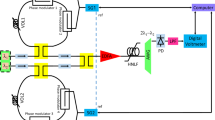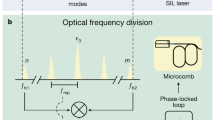Abstract
The next generation of radar (radio detection and ranging) systems needs to be based on software-defined radio to adapt to variable environments, with higher carrier frequencies for smaller antennas and broadened bandwidth for increased resolution1,2,3,4. Today’s digital microwave components (synthesizers and analogue-to-digital converters) suffer from limited bandwidth with high noise at increasing frequencies5,6,7, so that fully digital radar systems can work up to only a few gigahertz, and noisy analogue up- and downconversions are necessary for higher frequencies. In contrast, photonics provide high precision and ultrawide bandwidth8,9, allowing both the flexible generation of extremely stable radio-frequency signals with arbitrary waveforms up to millimetre waves10,11,12,13,14,15,16,17,18,19,20,21,22, and the detection of such signals and their precise direct digitization without downconversion23,24,25,26. Until now, the photonics-based generation and detection of radio-frequency signals have been studied separately and have not been tested in a radar system. Here we present the development and the field trial results of a fully photonics-based coherent radar demonstrator carried out within the project PHODIR27. The proposed architecture exploits a single pulsed laser for generating tunable radar signals and receiving their echoes, avoiding radio-frequency up- and downconversion and guaranteeing both the software-defined approach and high resolution. Its performance exceeds state-of-the-art electronics at carrier frequencies above two gigahertz, and the detection of non-cooperating aeroplanes confirms the effectiveness and expected precision of the system.
This is a preview of subscription content, access via your institution
Access options
Subscribe to this journal
Receive 51 print issues and online access
$199.00 per year
only $3.90 per issue
Buy this article
- Purchase on Springer Link
- Instant access to full article PDF
Prices may be subject to local taxes which are calculated during checkout





Similar content being viewed by others
References
Skolnik, M. L. Introduction to Radar Systems 3rd edn (McGraw-Hill, 1980)
Haykin, S. Cognitive radar: a way of the future. IEEE Signal Process. Mag. 23, 30–40 (2006)
Ravenni, V. Performance evaluations of frequency diversity radar system. Proc. Eur. Microwave Conf. 1715–1718, http://dx.doi.org/10.1109/eumc.2007.4405545 (2007)
Tsui, J. B. Digital Techniques for Wideband Receivers 2nd edn (SciTech, 2004)
Scheer, J. A. & Kurtz, J. L. Coherent Radar Performance Estimation (Artech House, 1993)
Richards, M. A., Scheer, J. A. & Holm, W. A. Principle of Modern Radar: Basic Principles (SciTech Publishing, 2010)
Walden, R. Analog-to-Digital Conversion in the Early Twenty-First Century (Wiley Encyclopedia of Computer Science and Engineering, 2008)
Capmany, J. & Novak, D. Microwave photonics combines two worlds. Nature Photon. 1, 319–330 (2007)
Yao, J. Microwave photonics. J. Lightwave Technol. 27, 314–335 (2009)
Goldberg, L., Esman, R. D. & Williams, K. J. Generation and control of microwave signals by optical techniques. IEEE Proc. J. 139, 288–295 (1992)
Khan, M. H. et al. Ultrabroad-bandwidth arbitrary radiofrequency waveform generation with a silicon photonic chip-based spectral shaper. Nature Photon. 4, 117–122 (2010)
Serafino, G. et al. Stable optically generated RF signals from a fibre mode-locked laser. Proc. 23rd IEEE Photonics Soc. Ann. Meet. Abstr. TuK4, 193–194, http://dx.doi.org/10.1109/photonics.2010.5698824 (2010)
Yilmaz, T., DePriest, C. M., Turpin, T., Abeles, J. H. & Delfyett, P. J. Toward a photonic arbitrary waveform generator using a modelocked external cavity semiconductor laser. IEEE Photonics Technol. Lett. 14, 1608–1610 (2002)
Chou, J., Han, Y. & Jalali, B. Adaptive RF-photonic arbitrary waveform generator. IEEE Photonics Technol. Lett. 15, 581–583 (2003)
McKinney, J. D., Leaird, D. E. & Weiner, A. M. Millimeter-wave arbitrary waveform generation with a direct space-to-time pulse shaper. Opt. Lett. 27, 1345–1347 (2002)
Lin, I. S., McKinney, J. D. & Weiner, A. M. Photonic synthesis of broadband microwave arbitrary waveform applicable to ultrawideband communication. IEEE Microwave Wireless Components Lett. 15, 226–228 (2005)
Chi, H. & Yao, J. P. An approach to photonic generation of high frequency phase-coded RF pulses. IEEE Photonics Technol. Lett. 19, 768–770 (2007)
Li, Z., Li, W., Chi, H., Zhang, X. & Yao, J. Photonic generation of phase-coded microwave signal with large frequency tunability. IEEE Photonics Technol. Lett. 23, 712–714 (2011)
Ghelfi, P., Scotti, F., Laghezza, F. & Bogoni, A. Phase coding of RF pulses in photonics-aided frequency-agile coherent radar systems. IEEE J. Quantum Electron. 48, 1151–1157 (2012)
Ghelfi, P., Scotti, F., Laghezza, F. & Bogoni, A. Photonic generation of phase-modulated RF signals for pulse compression techniques in coherent radars. J. Lightwave Technol. 30, 1638–1644 (2012)
Maleki, L. et al. High performance, miniature hyper-parametric microwave photonic oscillator. Proc. IEEE Freq. Control Symp. 558–563, http://dx.doi.org/10.1109/freq.2010.5556265 (2010)
Maleki, L. The optoelectronic oscillator. Nature Photon. 5, 728–730 (2011)
Valley, G. C. Photonic analog-to-digital converters. Opt. Exp. 15, 1955–1982 (2007)
Khilo, A. et al. Photonic ADC: overcoming the bottleneck of electronic jitter. Opt. Exp. 20, 4454–4469 (2012)
Chou, J., Conway, J. A., Sefler, G. A., Valley, G. C. & Jalali, B. Photonic bandwidth compression front end for digital oscilloscopes. J. Lightwave Technol. 27, 5073–5077 (2009)
Laghezza, F. et al. Jitter-limited photonic analog-to-digital converter with 7 effective bits for wideband radar applications. Proc. IEEE Radar Conf. 1–5, http://dx.doi.org/10.1109/radar.2013.6586075 (2013)
Photonic-based Fully Digital Radar (PHODIR). http://www.phodir.eu (2009)
Ghelfi, P., Scotti, F., Nguyen, A. T., Serafino, G. & Bogoni, A. Novel architecture for a photonics-assisted radar transceiver based on a single mode-locking laser. IEEE Photonics Technol. Lett. 23, 639–641 (2011)
Pierno, L. et al. Optical switching matrix as time domain demultiplexer in photonic ADC. Proc. Eur. Microwave Integr. Circuits Conf. Abstr. EuMIC03.3, INSPEC accession number 13990947. (2013)
Ghelfi, P. et al. Photonic generation and independent steering of multiple RF signals for software defined radars. Opt. Exp. 21, 22905–22910 (2013)
Acknowledgements
This work was supported by the ERC projects PHODIR (contract number 239640) and PREPARE (contract number 324629), and by the EU NEXPRESSO programme through the project INSIDE with Selex Sistemi Integrati S.p.A. (now Selex ES S.p.A.).
Author information
Authors and Affiliations
Contributions
A.B. coordinated all the activities of the PHODIR project. A.B. and P.G. designed the architecture of the photonics-based transceiver and wrote the paper. F.L., A.C. and F.B. defined the radar parameters and designed the RF front end. F.L., F.S., S.P., G.S., E.L. and D.O. implemented the photonic subsystems. S.P. designed and developed the electronic controls of the machine that separates the samples into parallel streams and of the front panels of the radar demonstrator. F.S. assembled the demonstrator. F.L. implemented the digital processing tools. P.G., G.S., M.S., E.L. and A.B. analysed and discussed the results from the photonics-based transmitter. P.G., F.L., F.S., S.P., D.O., A.M. and A.B. analysed and discussed the results from the photonics-based receiver. F.L., F.S., S.P., G.S. and D.O. collected and processed the data of the field trial. P.G., F.L., F.S., G.S., S.P., D.O. and A.B. analysed and discussed the results of the field trial. C.P., V.V., P.G. and A.B. discussed the possible development of the photonics-based transceiver with integrated photonics techniques. P.G., G.S., F.L., F.S. and A.B. commented on the manuscript.
Corresponding author
Ethics declarations
Competing interests
The authors declare no competing financial interests.
Rights and permissions
About this article
Cite this article
Ghelfi, P., Laghezza, F., Scotti, F. et al. A fully photonics-based coherent radar system. Nature 507, 341–345 (2014). https://doi.org/10.1038/nature13078
Received:
Accepted:
Published:
Issue Date:
DOI: https://doi.org/10.1038/nature13078
This article is cited by
-
A system-on-chip microwave photonic processor solves dynamic RF interference in real time with picosecond latency
Light: Science & Applications (2024)
-
Integrated optical frequency division for microwave and mmWave generation
Nature (2024)
-
Femtosecond-precision electronic clock distribution in CMOS chips by injecting frequency comb-extracted photocurrent pulses
Nature Communications (2023)
-
All-fibre phase filters with 1-GHz resolution for high-speed passive optical logic processing
Nature Communications (2023)
-
Experimental realization of a 12,000-finesse laser cavity based on a low-noise microstructured mirror
Communications Physics (2023)
Comments
By submitting a comment you agree to abide by our Terms and Community Guidelines. If you find something abusive or that does not comply with our terms or guidelines please flag it as inappropriate.



